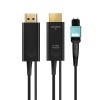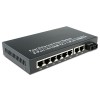MTP/MPO Cables

MTP®/MPO Cables: What Are They and How to Use Them?
With ever-greater bandwidths and network connections to deal with in data centers, conventional dual-fiber patch cables like LC cables are no longer sufficient to meet the demands. To solve this problem, MTP®/MPO cables accommodating more fibers in one multi-fiber MTP®/MPO connector came into the market, which proves to be practical solutions for 40G/100G/400G/800G high-density cabling in data centers. This article is going to introduce different MTP®/MPO cable types and their applications.
What Are MTP®/MPO Cables?
MPO (Multi-Fiber Push-on) is the first generation of clip clamping multi-core optical fiber connectors. MTP® is a registered trademark of US Conec Ltd., which is an advanced version of MPO, with better mechanical and optical performance. They look alike and are completely compatible and intermateable. And there are three MTP®/MPO cable types: MTP®/MPO Trunk Cables, MTP®/MPO Harness Cables and MTP®/MPO Conversion Cables.
MTP®/MPO cables are composed of MTP®/MPO connectors and optical fibers. MTP®/MPO connectors have a female type (without pins) or a male one (with pins). MTP®/MPO connectors greatly increase cable density and save circuit card and rack space, which are well suited for current 40G/100G cabling and future network speed upgrades.

Figure 1: MTP®/MPO Connector Structure.
Applications of MTP®/MPO Cable Types in 5 Performances
MTP®/MPO cable types are dominated by 5 performances including function, polarity, fiber count, fiber mode and jacket rating. Various MTP®/MPO cables are available for different application environments and requirements.
By Function
Three MTP®/MPO cable types, such as trunk cables, MTP®/MPO breakout cables, and MTP®/MPO conversion cables, are well suited for high-density cabling networks, providing better network capacity and flexibility.
MTP®/MPO Trunk Cables
MTP®/MPO trunk cables are terminated with an MTP®/MPO connector (female/male) on both ends, which are available in 8-144 fiber counts for users’ choices. Typically, these multi-fiber MTP®/MPO trunk cables are ideal for creating a structured cabling system, including backbone and horizontal interconnections such as 40G-40G and 100G-100G direct connections.

Figure 2: 40G-40G Direct Connection with MTP®/MPO Trunk Cable.
MTP®/MPO Breakout Cables
MTP®/MPO breakout cables (aka. harness cables or fanout cables) are terminated with a female/male MTP®/MPO connector on one end and 4/6/8/12 duplex LC/FC/SC/ST connectors on the other end, such as 8-fiber MTP®/MPO to 4 LC harness cables and 12-fiber MTP®/MPO to 6 LC harness cables. Typically, these breakout cables are ideal for short-range 10G-40G and 25G-100G direct connections or for connecting backbone assemblies to a rack system in the high-density backbone cabling.

Figure 3: 25G-100G Direct Connection with MTP®/MPO Breakout Cable.
MTP®/MPO Conversion Cables
MTP®/MPO conversion cables have the same fanout design as MTP®/MPO breakout cables but differ in fiber counts and types. They are terminated with MTP®/MPO connectors on both ends. Specifically, commonly-used ones are 24-fiber to 2×12-fiber, 24-fiber to 3×8-fiber, 2×12-fiber to 3×8-fiber MTP®/MPO conversion cables. They are especially ideal for 10G-40G, 40G-40G, 40G-100G, 40G-120G connections, which eliminate fiber wasting and largely increase the flexibility of MTP®/MPO cabling system.

Figure 4: 40G-120G Direct Connection with MTP®/MPO Conversion Cable.
By Polarity
MTP®/MPO cable types by polarity refer to the difference between the optical transmitters and receivers at both ends of the fiber link. Due to the special design of MTP®/MPO connectors, polarity issues must be addressed in high-density MTP®/MPO cabling systems.
The TIA 568 standard defines three connection methods to ensure the correct polarity of the optical path, called Type A, Type B, and Type C. The cables of the three MTP®/MPO connector types have different structures. Read the white paper Understanding MTP®/MPO Cable Polarity for more information about common 8/12/24-fiber MTP®/MPO cable polarity and connectivity methods. And now, ANSI/TIA-568.3-E introduced two new universal polarity methods: U1 and U2, which can streamline fiber cabling installations and maintenance.

Figure 5: 12-Fiber MTP®/MPO Cable Polarity.
By Fiber Count
MTP®/MPO cable types with different cores are classified into 8/12/24 cores, usually used for 40G/100G. The latest 16-fiber cables are especially designed for short-reach 400G cabling in hyperscale data centers.
· 8-fiber MTP®/MPO cable systems can transmit the same data rates as 12-fiber cables with lower cost and insertion loss, making them more cost-effective.
· 12-fiber MTP®/MPO cables are the earliest developed and most commonly used solution in 10G-40G, 40G-100G connections. If they are used in 40G QSFP+ or 100G QSFP28 transceivers, 4 fibers will be idle, resulting in low fiber utilization.
· 24-fiber MTP®/MPO cables are typically used to establish a 100GBASE-SR10 link between CFP-to-CFP transceivers.
· 16-fiber MTP®/MPO cables use the same external footprint as traditional 12-fiber MT (mechanically transferable) ferrules, aggregate multiple 8-fiber parallel transceivers, and couple directly to emerging 16-fiber parallel fiber links such as 400G QSFP- DD and OSFP.
By Fiber Mode
According to Fiber Mode, MTP®/MPO cable types include multimode OM3/OM4/OM5 and single-mode OS2 cables. Multimode OM3/OM4/OM5 MTP®/MPO cables are suitable for short distance transmission, allowing 40 Git/s maximum transmission distance of 300m/400m/440m respectively(with corresponding module). Single-mode OS2 MTP®/MPO cables are suitable for long-distance transmission, such as in Metropolitan Area Networks (MANs) and PONs (Passive Optical Networks). With less modal dispersion, the bandwidth of OS2 is higher than OM3/OM4/OM5. The maximum transmission distance that can be achieved by MTP cables is listed below. Please note that it needs to be used with the corresponding module to achieve the maximum distance transmission. For example, a single-mode mtp-12 trunk needs to be used with a 40G QSFP-PLR4-40G module to achieve 10km transmission.

By Jacket Rating
According to different fire rating requirements, the jackets of MTP®/MPO cable types are classified as LSZH (Low Smoke Zero Halogen), OFNP (Optical Fiber Nonconductive, Plenum), CMP (Communications Multipurpose Cable, Plenum) etc.
LSZH MTP®/MPO cables are free of halogenated materials (toxic and corrosive during combustion), which can better protect personnel and equipment during fires and are suitable for closed places.
OFNP MTP®/MPO cables contain no electrically conductive elements and are designed with the highest fire rating, which can be installed in ducts, plenums and other spaces for building airflow.
CMP MTP®/MPO cables can restrict flame propagation and smoke exhaust rate during a fire, which are suitable for plenum spaces, where air circulation for heating and air conditioning systems are facilitated.
Conclusion
The MTP®/MPO cable types distinguished by five features make it easier to filter out the network connection solution that suits specific needs. MTP®/MPO cables are well-received for high-density cabling in data centers, as they are capable of accommodating multi fibers within a single interface, which largely increases network capacity, saves a lot of space and offers ease of cable management.







